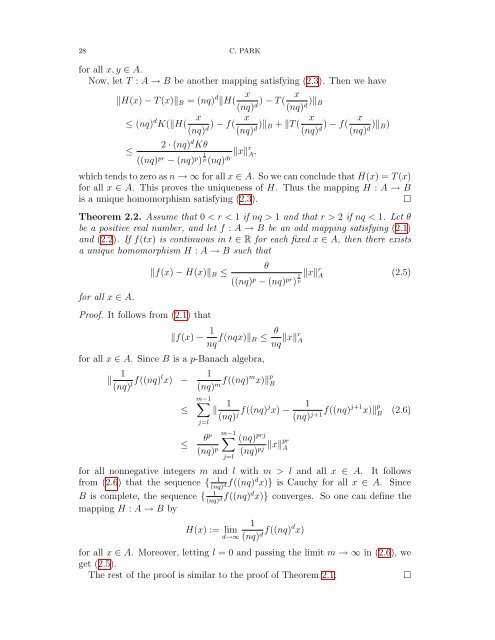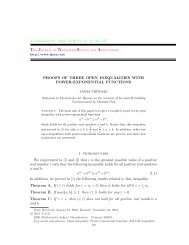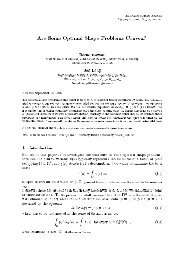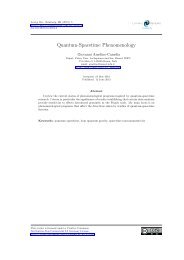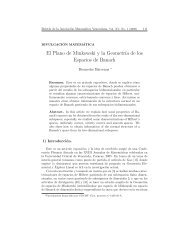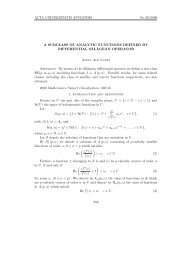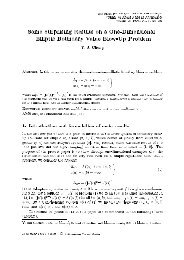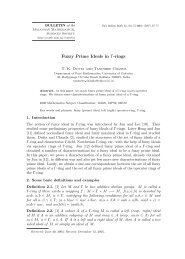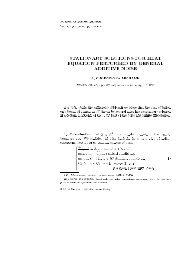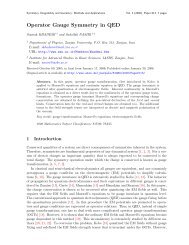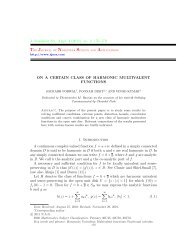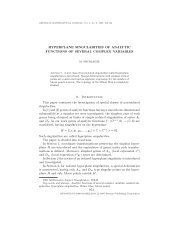Hyers-Ulam-Rassias stability of homomorphisms in quasi-Banach ...
Hyers-Ulam-Rassias stability of homomorphisms in quasi-Banach ...
Hyers-Ulam-Rassias stability of homomorphisms in quasi-Banach ...
- No tags were found...
Create successful ePaper yourself
Turn your PDF publications into a flip-book with our unique Google optimized e-Paper software.
28 C. PARKfor all x, y ∈ A.Now, let T : A → B be another mapp<strong>in</strong>g satisfy<strong>in</strong>g (2.3). Then we have‖H(x) − T (x)‖ B = (nq) d x‖H((nq) ) − T ( xd (nq) )‖ d B≤ (nq) d xK(‖H((nq) ) − f( xd (nq) )‖ xd B + ‖T ((nq) ) − f( xd (nq) )‖ B)d≤2 · (nq) d Kθ((nq) pr − (nq) p ) 1 p (nq)dr ‖x‖r A,which tends to zero as n → ∞ for all x ∈ A. So we can conclude that H(x) = T (x)for all x ∈ A. This proves the uniqueness <strong>of</strong> H. Thus the mapp<strong>in</strong>g H : A → Bis a unique homomorphism satisfy<strong>in</strong>g (2.3).□Theorem 2.2. Assume that 0 < r < 1 if nq > 1 and that r > 2 if nq < 1. Let θbe a positive real number, and let f : A → B be an odd mapp<strong>in</strong>g satisfy<strong>in</strong>g (2.1)and (2.2). If f(tx) is cont<strong>in</strong>uous <strong>in</strong> t ∈ R for each fixed x ∈ A, then there existsa unique homomorphism H : A → B such thatfor all x ∈ A.‖f(x) − H(x)‖ B ≤Pro<strong>of</strong>. It follows from (2.1) thatθ‖x‖ r((nq) p − (nq) pr ) 1 A (2.5)p‖f(x) − 1 nq f(nqx)‖ B ≤ θ nq ‖x‖r Afor all x ∈ A. S<strong>in</strong>ce B is a p-<strong>Banach</strong> algebra,‖ 1(nq) l f((nq)l x)−≤≤1(nq) m f((nq)m x)‖ p Bm−1∑j=l‖ 1(nq) j f((nq)j x) −θ p m−1∑(nq) pj=l(nq) prj‖x‖pr(nq)pj A1(nq) j+1 f((nq)j+1 x)‖ p B (2.6)for all nonnegative <strong>in</strong>tegers m and l with m > l and all x ∈ A. It followsfrom (2.6) that the sequence { 1 f((nq) d x)} is Cauchy for all x ∈ A. S<strong>in</strong>ce(nq) dB is complete, the sequence { 1 f((nq) d x)} converges. So one can def<strong>in</strong>e the(nq) dmapp<strong>in</strong>g H : A → B by1H(x) := limd→∞ (nq) d f((nq)d x)for all x ∈ A. Moreover, lett<strong>in</strong>g l = 0 and pass<strong>in</strong>g the limit m → ∞ <strong>in</strong> (2.6), weget (2.5).The rest <strong>of</strong> the pro<strong>of</strong> is similar to the pro<strong>of</strong> <strong>of</strong> Theorem 2.1.□


